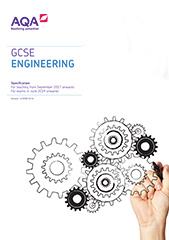Appendix 1: Mathematical understanding
A grasp of a range of mathematical concepts and skills is key to success in engineering. This section outlines the equations and mathematical skills students will be expected to recall and use within the exam. Not all of these equations and skills will be tested in every exam series but students may be asked to use any combination of equations and skills.
The mathematical content has been developed in order to support teaching of GCSE Engineering and should not be seen as an additional element. The skills in mathematics are not intended to be taught separately to the main content, but integrated into schemes of work. The skill groups are indicated in the subject content, using the references E1 (Equation 1), E2 (Equation 2) or M1 (Mathematical Skill 1), M2 (Mathematical Skill 2) etc.
Students should recognise, carry out calculations and be able to communicate using the following SI units: millimetres (mm), metres (m), kilograms (Kg), tonnes (T), newtons (N), volt (V), ohm (Ω); and the following SI multipliers: p, n, µ, m, k, M, G and T.
Students should also have knowledge and understanding of the following conversion of units:
• mm to cm
• cm to m
• litres to ml, to cm3, and to mm3
• kg to tonnes
• weight to mass.
Equations
Through their work in engineering, students will be expected to apply relevant knowledge, skills and understanding from Key Stage 3 and 4 courses in mathematics.
| Equation number | Description | Equation |
|---|---|---|
| E1 | Area of a rectangle | A=L×W |
| E2 | Volume of a cuboid | V = L × W × H |
| E3 | Area of a circle | Ac=πr2 |
| E4 | Volume of a cylinder | Vc=Ac×L |
| E5 | Area of a triangle | At=½(B×H) |
| E6 | Density = mass/volume | ρ=m/v |
| E7 | Stress = force/cross-sectional area | σ =F/A |
| E8 | Strain = change in length/original length | ε=δl/l |
| E9 | Young’s modulus = stress/strain | E=σ/ε |
| E10 | Pressure = force/area | P=F/A |
| E11 | Factor of safety = material strength/ yield stress | FoS=σy/L |
| E12 | Ohm’s law: current = voltage/resistance | I=V/R |
| E13 | Series resistance | Rt = R1 + R2 |
| E14 | Ratio of simple gears: Gear ratio = Number of teeth on driven gear/number of teeth on driver gear | |
| E15 | Mechanical Advantage = load/effort | MA=Fb/Fa |
Mathematical skills
M1 – Arithmetic and numerical computation
| Mathematical skill number | Description of skill |
|---|---|
| M1.1 | Recognise and use expressions in decimal form |
| M1.2 | Recognise and use expressions in standard index form |
| M1.3 | Perform calculations using time and cost |
| M1.4 | Use ratios, fractions and percentages |
| M1.5 | Calculate squares and square roots |
| M1.6 | Calculate angles of a triangle using trigonometry |
| M1.7 | Use Pythagoras’ theorem |
M2 – Handling data
|
Mathematical skill number |
Description of skill |
|---|---|
| M2.1 | use an appropriate number of significant figures |
| M2.2 | find arithmetic means |
| M2.3 | make order of magnitude calculations |
| M2.4 | collection, organisation and presentation of data |
M3 – Algebra
| Mathematical skill number | Description of skill |
|---|---|
| M3.1 | understand and use the symbols =, <, ≤, ≥, >, ±, α, ~ |
| M3.2 | change the subject of an equation |
| M3.3 | substitute numerical values into algebraic equations using appropriate units for physical quantities |
| M3.4 | solve simple algebraic equations |
M4 – Graphs
| Mathematical skill number | Description of skill |
|---|---|
| M4.1 | translate information between graphical and numeric form |
| M4.2 | plot two variables from experimental or other data |
| M4.3 | draw an appropriate trend line onto plotted data |
| M4.4 | determine the slope of a graph |
| M4.5 | interpret data presented in graphical form |
